It looks like you're using an Ad Blocker.
Please white-list or disable AboveTopSecret.com in your ad-blocking tool.
Thank you.
Some features of ATS will be disabled while you continue to use an ad-blocker.
share:
reply to post by LUXUS
You're ignoring the biological and cultural affinity exhibited among Nile Valley populations. Plus, SirShawn has a point. Those sources you gave us are not peer-reviewed.
You're ignoring the biological and cultural affinity exhibited among Nile Valley populations. Plus, SirShawn has a point. Those sources you gave us are not peer-reviewed.
Let's see what the white racist's response is to this study's findings on comparison of the biological affinities of the ancient Egyptians towards
African populations (Sudanese and West Africans) compared to Middle Easterners:
Gee now why would a non black African population group with black Africans rather Mediterranean populations, if they were not black Africans to begin with.
"Overall, when the Egyptian crania are evaluated in a Near Eastern (Lachish) versus African (Kerma, Jebel Moya, Ashanti) context) the affinity is with the Africans. The Sudan and Palestine are the most appropriate comparative regions which would have 'donated' people, along with the Sahara and Maghreb. Archaeology validates looking to these regions for population flow (see Hassan 1988)... Egyptian groups showed less overall affinity to Palestinian and Byzantine remains than to other African series, especially Sudanese." S. O. Y. Keita, "Studies and Comments on Ancient Egyptian Biological Relationships," History in Africa 20 (1993) 129-54
Gee now why would a non black African population group with black Africans rather Mediterranean populations, if they were not black Africans to begin with.
reply to post by LUXUS
There are men in those pictures!
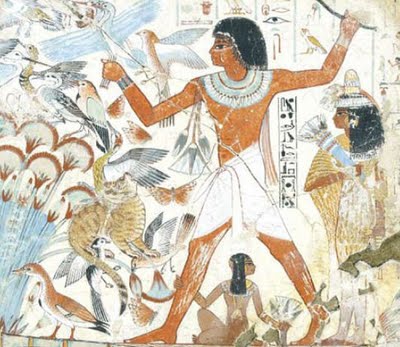
That's A MAN to the left of the woman.
And here,
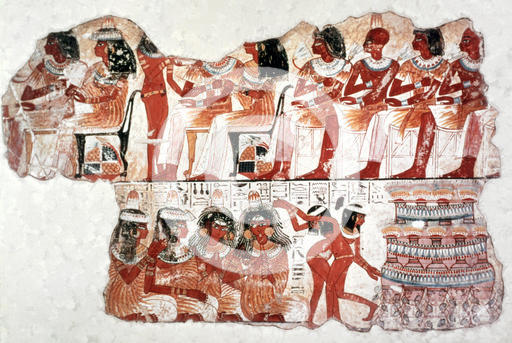
The men are clearly the ones with the shorter hair and without the headbands. The person sitting at the far left in the top row is a MAN and to the far right, the first 4 are MEN.
You seem to be trolling right now.
There are men in those pictures!

That's A MAN to the left of the woman.
And here,

The men are clearly the ones with the shorter hair and without the headbands. The person sitting at the far left in the top row is a MAN and to the far right, the first 4 are MEN.
You seem to be trolling right now.
edit on 11/12/2011 by IEtherianSoul9 because: (no reason given)
reply to post by LUXUS
Please remove this stereotypical image of 'blacks' with only 'negroid' features from your mind. Again, I've asked you to define what 'black' means, and you haven't replied yet.
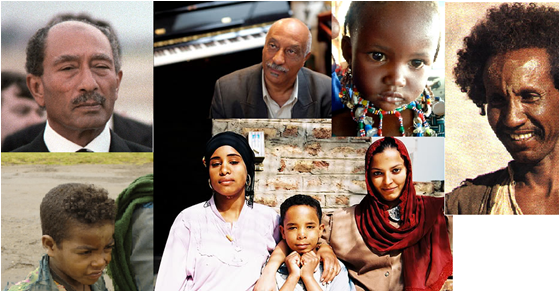
So are these people 'black' from your perspective? Huh?
And you continue to ignore the biological and cultural evidence to support the notion that ancient Egypt had southern origins and inhabitants.
Please remove this stereotypical image of 'blacks' with only 'negroid' features from your mind. Again, I've asked you to define what 'black' means, and you haven't replied yet.

So are these people 'black' from your perspective? Huh?
And you continue to ignore the biological and cultural evidence to support the notion that ancient Egypt had southern origins and inhabitants.
edit on 11/12/2011 by IEtherianSoul9 because: (no reason given)
IEtheriansoul , thanks for your answer to my question on page 2 .
Am I missing something here ?
There are all types / colours of Egyptians .
So where is the problem again ?
Am I missing something here ?
There are all types / colours of Egyptians .
So where is the problem again ?
edit on 12-11-2011 by 23432 because: edit
New Kingdom family Tree
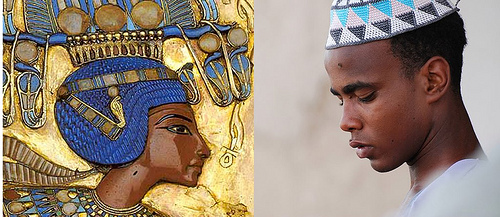
King Tut
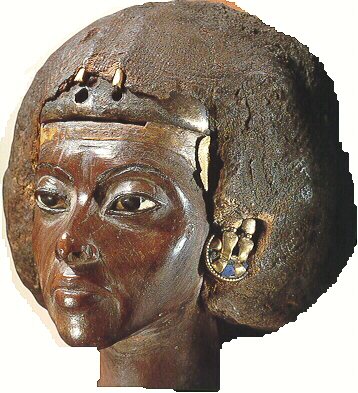
Tiye-Grandmother
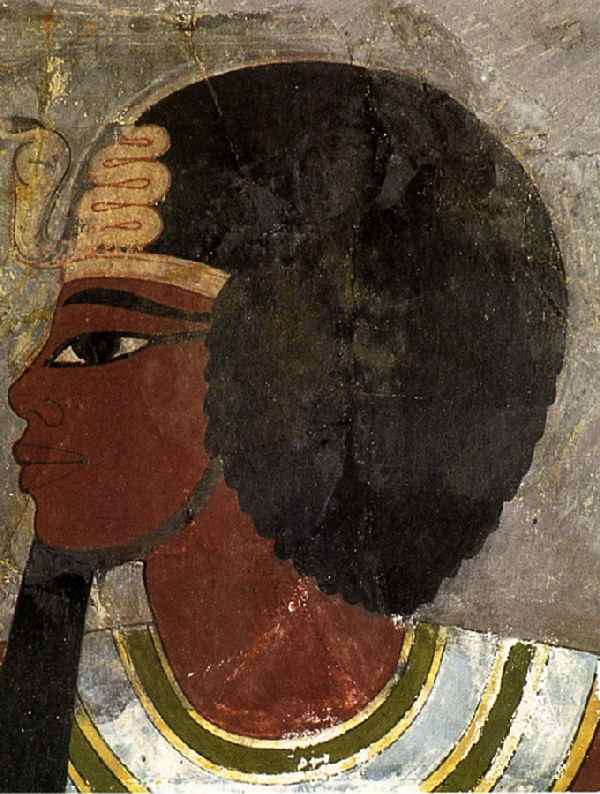
Amenhotep-Grandfather
Confirmation of the limb proportion analysis which group 18th and 19th Dynasty (along with Pre-Old-Middle Kingdom) as Negroes. The ancient Egyptians were black get over it!

King Tut

Tiye-Grandmother

Amenhotep-Grandfather
Confirmation of the limb proportion analysis which group 18th and 19th Dynasty (along with Pre-Old-Middle Kingdom) as Negroes. The ancient Egyptians were black get over it!
And what was that somebody said about who would start spamming with selective pictures depicting race
An examination of craniums from upper and lower Egypt by a team lead by professor C.Loring Brace
docs.google.com...
A forensic examination of Tutankhamen’s skull
news.nationalgeographic.com...
The Predynastic of Upper Egypt and the Late Dynastic of Lower Egypt are more closely related to each other than to any other population. As a whole, they show ties with the European Neolithic, North Africa, modern Europe, and, more remotely, India, but not at all with sub-Saharan Africa, eastern Asia, Oceania, or the New World.
An examination of craniums from upper and lower Egypt by a team lead by professor C.Loring Brace
docs.google.com...
“First a CT-scan-based skull model was made for forensic anthropologist Jean-Noël Vignal of the Centre Technique de la Gendarmerie Nationale. Vignal typically works with police to reconstruct victims of violent crime. He identified the skull as that of a male, 18 to 20 years old, with Caucasoid features. "
A forensic examination of Tutankhamen’s skull
news.nationalgeographic.com...
edit on 12-11-2011 by LUXUS because: (no reason given)
reply to post by 23432
I realize that. And I'm not saying ancient Egypt was one color throughout the time it existed. Of course it could not have remained completely homogeneous especially with an influx of foreigners resulting in an admixture (mainly in Lower Egypt).
This problem over the 'race' of the ancient Egyptians came up due to Luxus.
I realize that. And I'm not saying ancient Egypt was one color throughout the time it existed. Of course it could not have remained completely homogeneous especially with an influx of foreigners resulting in an admixture (mainly in Lower Egypt).
This problem over the 'race' of the ancient Egyptians came up due to Luxus.
reply to post by LUXUS
The difference between me posting pictures and you, is that I actually I present biological research to back my own subjective opinion (art work). You on the other hand up until now have based your argument on nothing more than picture spamming and from that spam attempting to make biological inferences to contest REAL biological research.
As far as Brace 93 goes, it has long been DEBUNKED! The results that you cite have yet to be supported by another study on the subject. Compare that to the works of Keita (cited in my last post), who's findings flat out contradict those of which you cite, but are also cited by just about every study which deals with this question. This is why Keita is considered an authority on the subject. Below is what he had to say about Brace's study:
Hell even Brace himself has recanted the findings of his 1993 study in his 2006 study. In it he groups the ancient Egyptians with other Northeast Africans and other tropical African populations in which no shows absolutely no relationship with modern Europeans or Middle Easterners"
Here are the plotting graph's of Brace 2006 which demonstrate how he corrects his mistakes of his previous study:
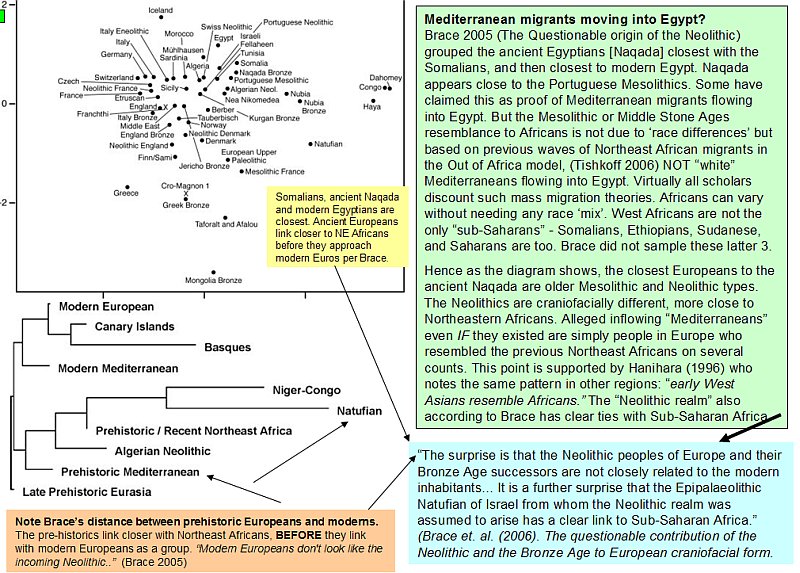
Confirmation that the ancient Egyptians were black Africans!
The difference between me posting pictures and you, is that I actually I present biological research to back my own subjective opinion (art work). You on the other hand up until now have based your argument on nothing more than picture spamming and from that spam attempting to make biological inferences to contest REAL biological research.
As far as Brace 93 goes, it has long been DEBUNKED! The results that you cite have yet to be supported by another study on the subject. Compare that to the works of Keita (cited in my last post), who's findings flat out contradict those of which you cite, but are also cited by just about every study which deals with this question. This is why Keita is considered an authority on the subject. Below is what he had to say about Brace's study:
"However, Brace et al. (1993) find that a series of upper Egyptian/Nubian epipalaeolithic crania affiliate by cluster analysis with groups they designate “sub-Saharan African” or just simply “African” (from which they incorrectly exclude the Maghreb, Sudan, and the Horn of Africa), whereas post-Badarian southern predynastic and a late dynastic northern series (called “E” or Gizeh) cluster together, and secondarily with Europeans. In the primary cluster with the Egyptian groups are also remains representing populations from the ancient Sudan and recent Somalia. Brace et al. (1993) seemingly interpret these results as indicating a population relationship from Scandinavia to the Horn of Africa, although the mechanism for this is not clearly stated; they also state that the Egyptians had no relationship with sub-Saharan Africans, a group that they nearly treat (incorrectly) as monolithic, although sometimes seemingly including Somalia, which directly undermines aspects of their claims. Sub-Saharan Africa does not define/delimit authentic Africanity." (S.O.Y. Keita. "Early Nile Valley Farmers from El-Badari: Aboriginals or "European" Agro-Nostratic Immigrants? Craniometric Affinities Considered With Other Data". Journal of Black Studies, Vol. 36 No. 2, pp. 191-208 (2005)
Hell even Brace himself has recanted the findings of his 1993 study in his 2006 study. In it he groups the ancient Egyptians with other Northeast Africans and other tropical African populations in which no shows absolutely no relationship with modern Europeans or Middle Easterners"
"The Niger-Congo speakers, Congo, Dahomey and Haya, cluster closely with each other and a bit less closely with the Nubian sample, both the recent and the Bronze Age Nubians, and more remotely with the Naqada Bronze Age sample of Egypt, the modern Somalis, and the Arabic-speaking Fellaheen (farmers) of Israel. When those samples are separated and run in a single analysis as in Fig. 1, there clearly is a tie between them that is diluted the farther one gets from sub-Saharan Africa" -- Brace, et al. The questionable contribution of the Neolithic and the Bronze Age to European craniofacial form, Proc Natl Acad Sci U S A. 2006 January 3; 103(1): p. 242-247.)
Here are the plotting graph's of Brace 2006 which demonstrate how he corrects his mistakes of his previous study:

Confirmation that the ancient Egyptians were black Africans!
edit on 12-11-2011 by SirShawn because: text
Originally posted by LUXUS
“First a CT-scan-based skull model was made for forensic anthropologist Jean-Noël Vignal of the Centre Technique de la Gendarmerie Nationale. Vignal typically works with police to reconstruct victims of violent crime. He identified the skull as that of a male, 18 to 20 years old, with Caucasoid features. "
A forensic examination of Tutankhamen’s skull
news.nationalgeographic.com...[
Here is the email from the actual anthropologist who attempted to reconstruct Tut.
From: "Susan C Anton" [Add to Address Book] Add to Address Book To: email withheld Date: Fri, 02 Sep 2005 12:26:22 -0400 Subject: Re: North African ''caucasoid'' and European nose opening Tut-ankh-amu Dear name withheld,,
Thanks for your email. I actually didn't choose the term "North African Caucasoid" that is the term used by another team (there were three that worked on separate reconstructions). The French team was responsible for the reconstruction that was on the cover of National Geographic Magazine and they also used that term. Our team, myself and Michael Anderson of Yale, were the ones that did the plaster reconstruction without knowledge of whose skull we were working on. I did the biological profile (assessment of age at death, sex and ancestry), Michael made the actual reconstruction. Based on the physical characters of the skull, I concluded that this was the skull of a male older than 15 but less than 21, and likely in the 18-20 year range and of African ancestry, possibly north african. The possibly north african came mostly from the shape of the face including the narrow nose opening, that is not entirely consistent with an 'African' designation. A narrow nose is more typical of more northerly located populations because nose breadth is thought to be at least in part related to the climate in which ancestral populations lived. A narrow and tall nose is seen most frequently in Europeans. Tut's head was a bit of a conundrum, but, as you note, there is a huge range of variation in modern humans from any area, so for me the skull overall, including aspects of the face, spoke fairly strongly of his African origins - the nose was a bit unusual. Because their is latitudinal variation in several aspects of the skull (including nose size/shape), the narrowness of the nose suggested that he might be from a northerly group. This is also, I presume, what the French focussed on. I have not been in direct contact with the French group, but my understanding is that by their definition of 'caucasoid' they include Peoples from North Africa, Peoples from Western Asia (and the Caucasus, from where the term derives), and Eureopean peoples. So I don't think that they were referring to a specific set of those peoples. I personally don't find that term all that useful and so I don't use it. That it was attributed to me by the media is an incorrect attribution on their part. I also never said he had a European nose, although I am sure I did say that the narrow nose was what led me to suggest North Africa as a possibility and that a narrow nose is more typically seen in Europe. Not a great sound-bit that, so I guess it gets shortened to European nose. As you also note, skin color today in North Africa can range from much lighter than what they chose to much darker. And we don't know how well today's range matches that of the past, although I suspect there was also a range of variation in the past, as is normal for any biological population. Michael's reconstruction did not include an inference of skin color (or eye color), the French team's did and their inference was, I understand, based on a 'average' skin tone for Egypt today. I don't know the specifics of how they did that. I think, however, it would have been as accurate to have had the same facial reconstruction with either a lighter tone or a darker tone to the skin. That said, skin and eye color will always be an inference. I hope that helps explain. Susan..............
We classified him as African based on many of the [skull's facio-cranial] features...."
With regard to any finding of European origins, Antón further commented that she "determined the statistical association was very low and, therefore, based on the nonmetric characters, was not likely to be accurate."
The team refused, however, to assign a specific racial designation to the specimen, citing inherent problems with the concept of race.
Further, the Americans did not assign skin or eye color. Referring to the skull's pronounced dolichocephalism, alveolar prognathism, "large teeth," receding chin and sloping cranium, Antón stated she was "in general agreement that, based on the cranial skeleton, an estimate of African is appropriate.
Susan C. Antón Joint Editor, Journal of Human Evolution Director, MA Program in Human Skeletal Biology Asso
Full citation for email:
So according to the email the skin tone given to Tut was nothing more than a wild guess on the part of the French team. Not to mention that this reconstruction drew criticism not only from the African American community but also from the within Egypt itself. In fact the a member of the antiquities counsel stated this about the reconstruction:
Hence modern Egyptians themselves are aware that their core indigenous ancestors were black Africans from the south. The only people who seem to piss their pants at that revelation are racist white folk.
Also here is the Discovery Channel facial reconstruction of King Tut:
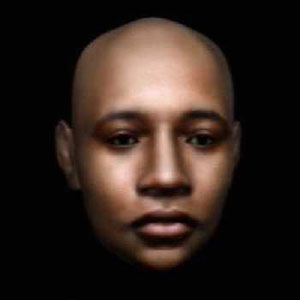
Susan C. Antón Joint Editor, Journal of Human Evolution Director, MA Program in Human Skeletal Biology Associate Professor, Center for the Study of Human Origins Department of Anthropology NYU 25 Waverly Place, New York, NY 10003 (212)992-9786 MA program website www.nyu.edu...
So according to the email the skin tone given to Tut was nothing more than a wild guess on the part of the French team. Not to mention that this reconstruction drew criticism not only from the African American community but also from the within Egypt itself. In fact the a member of the antiquities counsel stated this about the reconstruction:
Within Egypt, Hawass has been brawling lately with critics who question the methodology of the CT scan of Tut's mummy, and the forensic re-creation of his face. Hawass curbed the authority and docked the pay of one persistent foe, Ahmed Saleh, an archeological inspector for the Supreme Council who complained, among other things, that the procedures used in the facial re-creation made Tut look Caucasian, disrespecting the nation's African roots.(Copyright (c) 2005 Los Angeles Times)
Hence modern Egyptians themselves are aware that their core indigenous ancestors were black Africans from the south. The only people who seem to piss their pants at that revelation are racist white folk.
Also here is the Discovery Channel facial reconstruction of King Tut:

edit on 12-11-2011 by SirShawn because: (no reason given)
LUXUS your bull# assertion have been flat out destroyed. Give it up and get off of ancient Africa's jock! The original ancient Egyptians were
Negroes, not white folk.
I've yet to see a white man with facial features like this:

You should focus on Europe not Africa!
I've yet to see a white man with facial features like this:

You should focus on Europe not Africa!
Originally posted by IEtherianSoul9
reply to post by 23432
This problem over the 'race' of the ancient Egyptians came up due to Luxus.
Hahaha….your just too funny mate, my posts caused a problem because I said the Egyptians weren’t black even though dna testing of the pyramid builders proves that they are the ancestors of modern Egyptians (please do look at the videos I posted) and btw funny how you simply overlook the fact that at the end of every post SirShawn made he said Egyptians are “black”…double standards perhaps
Originally posted by SirShawn
reply to post by LUXUS
The difference between me posting pictures and you, is that I actually I present biological research to back my own subjective opinion (art work). You on the other hand up until now have based your argument on nothing more than picture spamming and from that spam attempting to make biological inferences to contest REAL biological research.
Yeah right dude, what you meant to say is the difference between what you post and what I post is you post evidence that I don’t like.
My posting of pictures is actually more factual then yours to demonstrate that Egyptians did indeed depict men in a darker colour to women….and I encourage everyone to do a google image search to confirm this!
To obtain the frequencies of these mtDNA types, amplification of the HVRI region and three RFLP markers was conducted. The authors succeeded in analysing RFLP markers in 34 samples and HVRI sequences in 18 of the samples. Both populations, ancient and contemporary, fit the north-south clinal distribution of “southern” and “northern” mtDNA types (Graver et al. 2001). However, significant differences were found between these populations. Based on an increased frequency of HpaI 3592 (+) haplotypes in the contemporary Dakhlehian population, the authors suggested that, since Roman times, gene flow from the Sub-Saharan region has affected gene frequencies of individuals from the oasis.
Mitochondrial DNA Research in the Dakhleh Oasis, Egypt Alison M. Graver, Ryan L. Parr, Sandra Walters, Renée C. Praymak, Jennifer M. Maki and J.El Molto
And the findings of that study presented in video format if you prefer:
Basically the only mass migration into lower Egypt in the last few thousand years has been by Nubians ie they were the minority in ancient Egypt which is backed up by the dna testing of the pyramid builders!
edit on 13-11-2011 by LUXUS because: (no reason given)
Originally posted by LUXUS
Where is Hierakonpolis??????
the word hierkanopolis is greek.....for nekhen.... it gets confusing because one place in egypt would have a greek name, arabic name, and ancient name.
heirkan = falcon
polis = city
called falcon city as it is where the horus kings of the first dynasty came from.
theyr nome god was a falcon....
ie
heliopolis = sun city - in ancient 'Anu"
necropolis = dead city "city of dead"
peace
edit on 13-11-2011 by thePharaoh because: (no reason given)
reply to post by thePharaoh
Yes I am aware of that, it was the home to the “shemsu-hor” the priests of Horus. It is one of if not the first civilisations along the Nile river and no Nubian mummy’s have been found there so far!
Yes I am aware of that, it was the home to the “shemsu-hor” the priests of Horus. It is one of if not the first civilisations along the Nile river and no Nubian mummy’s have been found there so far!
reply to post by LUXUS
Are you seriously that #ing dumb? No one denies that modern Egyptians are the descendants of the ancient Egyptians. What we have proven however is that throughout the last 5,000 the original Egyptian populace has undergone biological changes due migration from the Middle East and Europe. Here is another PEER REVIEWED study which confirms that the ancient Egyptians were black like Nubians and Horn Africans, prior to admixture from lighter skinned populations:
Confirmation that the original ancient Egyptians were black Africans.
Are you seriously that #ing dumb? No one denies that modern Egyptians are the descendants of the ancient Egyptians. What we have proven however is that throughout the last 5,000 the original Egyptian populace has undergone biological changes due migration from the Middle East and Europe. Here is another PEER REVIEWED study which confirms that the ancient Egyptians were black like Nubians and Horn Africans, prior to admixture from lighter skinned populations:
"As a result of their facial prognathism, the Badarian sample has been described as forming a morphological cluster with Nubian, Tigrean, and other southern (or Negroid") groups(Morant, 1935, 1937; Mukherjee et al., 1955; Nutter, 1958, Strouhal, 1971; Angel, 1972; Keita, 1990).Cranial nonmetric trait studies have found this group to be similar to other Egyptians, including much later material (Berry and Berry, 1967, 1972), but also to be significantly different from LPD material (Berry et al., 1967). Similarly, the study of dental nonmetric traits has suggested that the Badarian population is at the centroid of Egyptian dental samples (Irish, 2006), thereby suggesting similarity and hence continuity across Egyptian time periods. From the central location of the Badarian samples in Figure 2, the current study finds the Badarian to be relatively morphologically close to the centroid of all the Egyptian samples. The Badarian have been shown to exhibit greatest morphological similarity with the temporally successive EPD (Table 5). Finally, the biological distinctiveness of the Badarian from other Egyptian samples has also been demonstrated (Tables 6 and 7).
These results suggest that the EDyn do form a distinct morphological pattern. Their overlap with other Egyptian samples (in PC space, Fig. 2) suggests that although their morphology is distinctive, the pattern does overlap with the other time periods. These results therefore do not support the Petrie concept of a "Dynastic race" (Petrie, 1939; Derry, 1956). Instead, the results suggest that the Egyptian state was not the product of mass movement of populations into the Egyptian Nile region, but rather that it was the result of primarily indigenous development combined with prolonged small-scale migration, potentially from trade, military, or other contacts.
This evidence suggests that the process of state formation itself may have been mainly an indigenous process, but that it may have occurred in association with in-migration to the Abydos region of the Nile Valley. This potential in-migration may have occurred particularly during the EDyn and OK. A possible explanation is that the Egyptian state formed through increasing control of trade and raw materials, or due to military actions, potentially associated with the use of the Nile Valley as a corridor for prolonged small scale movements through the desert environment. (Sonia R. Zakrzewski. (2007). Population Continuity or Population Change: Formation of the Ancient Egyptian State. AMERICAN JOURNAL OF PHYSICAL ANTHROPOLOGY 132:501-509)
Confirmation that the original ancient Egyptians were black Africans.
edit on 13-11-2011 by SirShawn because: (no reason
given)
edit on 13-11-2011 by SirShawn because: (no reason given)
Originally posted by LUXUSTo obtain the frequencies of these mtDNA types, amplification of the HVRI region and three RFLP markers was conducted. The authors succeeded in analysing RFLP markers in 34 samples and HVRI sequences in 18 of the samples. Both populations, ancient and contemporary, fit the north-south clinal distribution of “southern” and “northern” mtDNA types (Graver et al. 2001). However, significant differences were found between these populations. Based on an increased frequency of HpaI 3592 (+) haplotypes in the contemporary Dakhlehian population, the authors suggested that, since Roman times, gene flow from the Sub-Saharan region has affected gene frequencies of individuals from the oasis. Mitochondrial DNA Research in the Dakhleh Oasis, Egypt Alison M. Graver, Ryan L. Parr, Sandra Walters, Renée C. Praymak, Jennifer M. Maki and J.El Molto
More recent genetic analysis of modern Egyptians and Sub Saharan East Africans population REFUTES that statement. They confirm that the most ancestral genetic component of modern Egyptians comes from Sub Saharan East Africa, and Middle Eastern and Europe contributions came later:
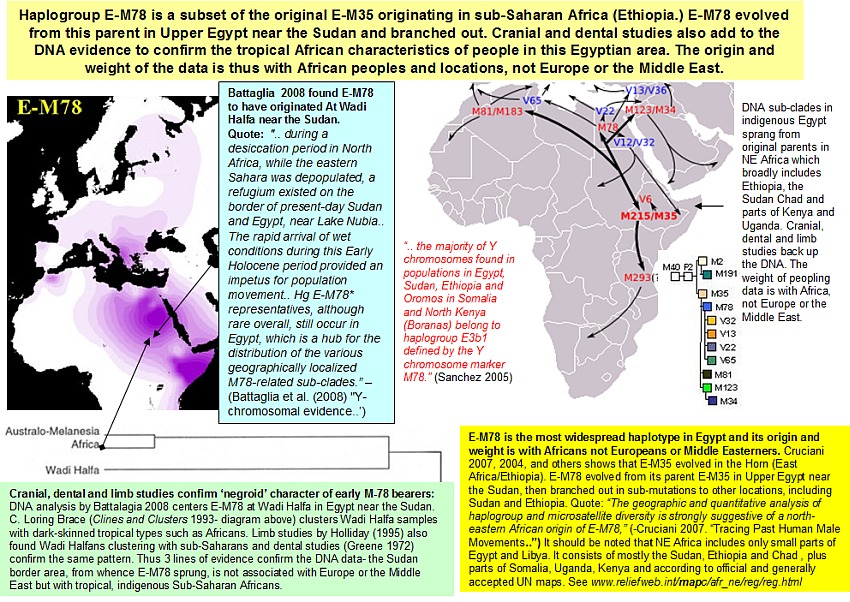
"The mitochondrial DNA (mtDNA) diversity of 58 individuals from Upper Egypt, more than half (34 individuals) from Gurna, whose population has an ancient cultural history, were studied by sequencing the control-region and screening diagnostic RFLP markers. This sedentary population presented similarities to the Ethiopian population by the L1 and L2 macrohaplogroup frequency (20.6%), by the West Eurasian component (defined by haplogroups H to K and T to X) and particularly by a high frequency (17.6%) of haplogroup M1. We statistically and phylogenetically analysed and compared the Gurna population with other Egyptian, Near East and sub-Saharan Africa populations; AMOVA and Minimum Spanning Network analysis showed that the Gurna population was not isolated from neighbouring populations. Our results suggest that the Gurna population has conserved the trace of an ancestral genetic structure from an ancestral East African population, characterized by a high M1 haplogroup frequency. The current structure of the Egyptian population may be the result of further influence of neighbouring populations on this ancestral population." (Stevanovitch A, Gilles A, Bouzaid E, et al. (2004) Mitochondrial DNA sequence diversity in a sedentary population from Egypt.Ann Hum Genet. 68(Pt 1):23-39.)
Notice dumb ass that the Sub Saharan East African affinities of both modern and ancient Egyptians has been confirmed by both genetics and anthropology. YOUR study is the only out-linear. Therefore your evidence is BUNK!
Once again get off of ancient Africa's History and focus on Europe Dumbass!
reply to post by LUXUS
Luxus, I could sense your presence from a mile away. I knew you were going to show up on this thread and continue such nonsense. Because I've seen you state things of a similar nature in the past. Again, you keep ignoring the biocultural evidence that SirShawn is posting by credible anthropologists. I also keep asking you to define what 'black' is, yet I'm still left without an answer.
Have you SEEN what modern Egyptians look LIKE!? You keep dodging questions.
Luxus, I could sense your presence from a mile away. I knew you were going to show up on this thread and continue such nonsense. Because I've seen you state things of a similar nature in the past. Again, you keep ignoring the biocultural evidence that SirShawn is posting by credible anthropologists. I also keep asking you to define what 'black' is, yet I'm still left without an answer.
Have you SEEN what modern Egyptians look LIKE!? You keep dodging questions.
new topics
-
Watch SpaceX Starship Test Flight 6 Live - Launch Starts 4pm CST , 2200 GMT.
Space Exploration: 2 hours ago -
Watch Dramatic Moment Ukrainian Nursery Teacher Takes Out Russian Missile With Rocket Launcher
Mainstream News: 3 hours ago -
He Had and It Has
Short Stories: 7 hours ago -
Morning’s Reverie
Short Stories: 10 hours ago
top topics
-
DefCon Teetering on Escalation
World War Three: 15 hours ago, 28 flags -
Democrat county officials openly declare intention to commit ballot fraud in PA
2024 Elections: 13 hours ago, 13 flags -
Morning’s Reverie
Short Stories: 10 hours ago, 3 flags -
He Had and It Has
Short Stories: 7 hours ago, 3 flags -
Watch SpaceX Starship Test Flight 6 Live - Launch Starts 4pm CST , 2200 GMT.
Space Exploration: 2 hours ago, 2 flags -
Watch Dramatic Moment Ukrainian Nursery Teacher Takes Out Russian Missile With Rocket Launcher
Mainstream News: 3 hours ago, 1 flags
active topics
-
Democrat county officials openly declare intention to commit ballot fraud in PA
2024 Elections • 9 • : Flyingclaydisk -
Watch SpaceX Starship Test Flight 6 Live - Launch Starts 4pm CST , 2200 GMT.
Space Exploration • 1 • : LetsGoViking -
Watch Dramatic Moment Ukrainian Nursery Teacher Takes Out Russian Missile With Rocket Launcher
Mainstream News • 8 • : Flyingclaydisk -
DefCon Teetering on Escalation
World War Three • 32 • : Lazy88 -
Incoming TRUMP Admin will Declare a National Emergency to Mass Deport People Here Illegally.
Social Issues and Civil Unrest • 97 • : Xtrozero -
Russia Ukraine Update Thread - part 3
World War Three • 6828 • : Arbitrageur -
-@TH3WH17ERABB17- -Q- ---TIME TO SHOW THE WORLD--- -Part- --44--
Dissecting Disinformation • 3305 • : MetalThunder -
The Acronym Game .. Pt.4
General Chit Chat • 973 • : Encia22 -
He Had and It Has
Short Stories • 2 • : nugget1 -
What is your most awesome achievement or proudest moment, RE: something you were responsible for?
General Chit Chat • 19 • : AlroyFarms
